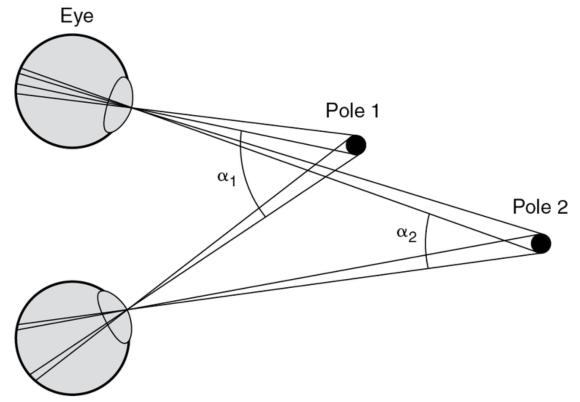Visual proprioception
This is an excerpt from Motor Control and Learning 6th Edition With Web Resource by Richard A. Schmidt,Timothy D. Lee,Carolee Winstein,Gabriele Wulf,Howard N. Zelaznik.
Figure 5.4 illustrates one of James Gibson's concepts about how changes in head position contribute to changes in the angles of light rays entering the eye (Gibson, 1966, 1979). The pattern of rays experienced is called the optical array, and it provides a unique specification of the location of the eye in space. The changes in the optical array when the eye is moved from one place to another are called the optical flow, implying that the visual environment "flows past us" as we move around. An important point is that the particular patterns of flow specify distinct kinds of movements of the eyes with respect to the environment. For example, if the angle between the light rays from two sides of an object is constant over time, this specifies that you are not moving with respect to that object. If the angle between these rays is increasing, then you are moving toward the object; if it is decreasing, you are moving away from it. Also, if the angles from two sides of an object (with respect to straight ahead) are increasing at the same rate, the eye is moving toward the center of the object (e.g., your eye(s) are moving toward the center of a picture on the wall). In conditions in which the angles from both sides of an object are changing in the same direction, if the rate of increase in the angle of the rays from the right side of the object is greater than the rate of increase from the left side and continues in this way, you will pass the object so that it is on your right side.

Figure 5.4 The detection of distance: The angles of the light rays from the distant pole change less than those from the near pole as the head and eyes are moved.
The optical flow generated as you move in the environment also tells you about the environment itself in ways that could not be achieved if you were stationary. For example, imagine looking out the window at two telephone poles as illustrated in figure 5.4. Which of them is closer? The question is difficult to answer if you remain still, because the poles appear to be nearly the same thickness and height. But if you move your head sideways, you can tell immediately. You will notice that one of the poles seems to "move more quickly" as you change head position. This, of course, is the same as saying that the angles of the rays received from one object changed more quickly (α1 in the figure) than did those from the other (α2), implying that pole 1 is closer than pole 2. Thus, the visual system, through movement of the entire head, body, or both, can provide rich information about the nature of the environment. In this view, vision is not merely an exteroceptive sense, passively providing information about the environment. It is also a proprioceptive sense telling us about our own movements. As well, vision is dependent on movement in some situations for informing us about the environment. In this way, vision and movement are very closely and reciprocally linked. Excellent discussions of this basic idea are found in Gibson (1966, 1979) and Lee (1980; Lee & Young, 1985), the latter showing relevance to many situations, such as sport-related motions and bird flight.
Learn more about Motor Control and Learning, Sixth Edition With Web Resource.
More Excerpts From Motor Control and Learning 6th Edition With Web ResourceSHOP

Get the latest insights with regular newsletters, plus periodic product information and special insider offers.
JOIN NOW
Latest Posts
- Big problem verses small problem activity
- Combining creativity with a structured framework to create fun and effective games
- Designing games to allow all students to experience success
- Examples of TR sensory stimulation activities
- Therapeutic recreation tools of the trade
- The four steps in the therapeutic recreation process


